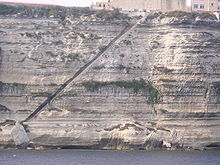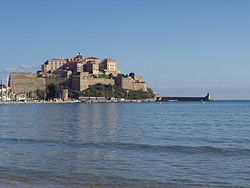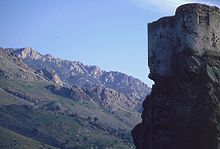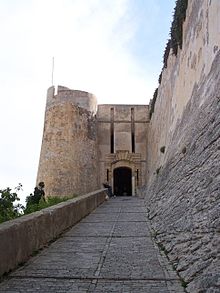- Medieval Corsica
-
Modified medieval citadel at Calvi

The history of Corsica in the medieval period begins with the collapse of the Western Roman Empire and the invasions of various Germanic peoples in the fifth century and ends with the complete subjection of the island to the authority of the Bank of San Giorgio in 1511.
Contents
Eastern Imperial suzerainty
 Germanic invasions of the Roman Empire. Note the Vandal invasion of Corsica. The arrows only approximate debatably large-scale people movements. There were many small movements of individuals and small groups within Europe and the Roman Empire in the so-called "Migration Period". The Vandal movement into Corsica represents a conquest and not an influx of Germanic emigrants.
Germanic invasions of the Roman Empire. Note the Vandal invasion of Corsica. The arrows only approximate debatably large-scale people movements. There were many small movements of individuals and small groups within Europe and the Roman Empire in the so-called "Migration Period". The Vandal movement into Corsica represents a conquest and not an influx of Germanic emigrants.
Barbarians and Byzantines
In the early decades of the fifth century, effective Roman authority all but vanished from Corsica. The island became disputed between the Ostrogoths, Roman foederati who were settled in the lands along the Riviera, and the Vandals, who had established a kingdom in Tunisia. Both groups were sometimes allies, sometimes enemies of the Romans and both followed a pattern of taking over Roman legal forms and structures and maintaining nominal deference to the empire while de facto creating autonomous kingdoms within its former borders. In 469 CE, Gaiseric, the Vandal king, finally completed the subjugation of the isle.[1] For the next 65 years the Vandals maintained their domination, the valuable Corsican forests supplying the wood for their pirate fleets.
After the Vandal state in Africa crumbled in the early sixth century under the onslaught of the Roman general Belisaurius, his lieutenant Cyril restored imperial rule of Corsica in 534 CE, and the island was placed under the government of the newly organized Exarchate of Africa.[2] However, the exarchate was not able to protect the island from the raiding by the Ostrogoths and the Lombards, who moved down into Italy from the north beginning in 568 CE. After the loss of the African mainland territories of the exarchate to the Umayyad dynasty in 709 CE, the empire's power in the West deteriorated further. Saracen raiders began to prey on Corsica, leading Liutprand the Lombard to invade circa 725 CE to preempt Saracen designs.[3]
Western Imperial suzerainty
Saracens and Franks
The first Muslim raid on Corsica took place in 713. These Muslims were probably Arabs from North Africa. After this, Byzantine authority, nominal under Lombard rule, waned further and in 774, after conquering the Lombard Kingdom of Italy, the Frankish king Charlemagne proceeded to conquer Corsica for the Frankish hegemony, the Carolingian Empire, which he was establishing in western Europe.
In 806, however, occurred the first of a series of Moorish incursions from Spain. Several times defeated by Charlemagne's lieutenants, like Burchard, his constable, in 807, the Moors continually returned, and in 810 were decisively defeated (even exterminated) by an alliance of local powers and the Franks.[4] They were crushed and exterminated by an expedition under Charles the Younger, but nonetheless continued their assaults. In 828, the defence of Corsica was entrusted to Boniface II of Tuscany, who conducted a successful expedition against the African Muslims and built the fortress later to bear his name (Bonifacio) in the south. For the next century, Corsica was a part of the March of Tuscany.[5]
Boniface' son Adalbert I continued to war against the Muslims after 846; but, in spite of all efforts, they seem to have remained in possession of part of the island until about 930.[4] During his conflicts with Otto I of Germany, Berengar II of Italy managed to make himself master of Corsica. In 962, Berengar was defeated and his son, Adalbert, fled to Corsica. He succeeded in holding the island against Otto and passing it on to his son, another Adalbert, who was defeated, however, by Otto II.[citation needed] Corsica was reattached to Tuscany, but Adalbert was allowed to hold as a fief.
Feudal anarchy
Following Otto II's reestablishment of imperial authority over Corsica, a period of feudal anarchy began. The island at this time appears to be generally divided, as it is down to the present time, into a north and a south. Throughout the island petty lords and more powerful regional potentates fought for supremacy and land. Among the lords of the south, the Counts of Cinarca soon gained preeminence. Soon after the year 1000, at a central location in the valley of Morosaglia, a sort of national diet or assembly was held with the intent of establish peace and rule of law over the whole island.[6] The movement for peace, reminiscent of the contemporary Peace and Truce of God movements in Languedoc, was headed by Sambucuccio, lord of Alando. The movement succeeded in establishing order in the north, establishing the Terra di Comune, but the south — and the Cape Corso — remained as anarchic as ever.
The Terra was modelled along republican lines and was composed of autonomous communes. Each commune, or parish, elected a council of "fathers of the commune" who were in charge of the administration of justice under the direction of the podestà. Each podestà of an enfranchised district (or state) in turn elected a member to the supreme council, or magistracy, which was as it were the legislature of the Terra. The supreme council was called the Twelve because that was the number of enfranchised communes. Finally, as a check on their power and that of the podestà, the fathers of each commune elected a caporale charged with looking out for the interests of the poor and defenceless.
In 1012, in a final effort to subdue the wild barons of the south and the northern cape, the Terra called in William, Margrave of Massa.[6] By 1020 he had succeeded in driving the count of Cinarca out of the island and enforcing peace, or at least reduced violence, on the southern barons. He allied with the communes and was able to hand Corsica on to his son, but his legacy was not one of unity and central government.[6]
Papal fief
Towards the end of the eleventh century, the Papacy laid claim to Corsica, saying it had been donated to the Church by Charlemagne. All Charlemagne had really done was promise that stolen ecclesiastical lands would be returned. Nevertheless, the clergy of Corsica supported the Papacy and, in 1077, the Corsicans declared themselves subject to the Holy See in the presence of Landulf, Bishop of Pisa and Apostolic Legate to the island. Pope Gregory VII responded by making Landulf and his successors saecular lords and perennial apostolic legates of the isle. This was confirmed by Urban II in 1190 and extended into a concession of full sovereignty.
Pisa replaced the papal legates who were governing the island with judges (judices) of their own appointment. Valuable chiefly as a source of timber for the Pisan fleet, but also as an important transit point for the slave trade, Corsica flourished under Pisan sovereignty, but crises soon arose.[7] The Corsican episcopate resented Pisan overlordship and the rival Republic of Genoa schemed to have Rome reverse the grant of 1077. In 1138, Pope Innocent II divided the ecclesiastical rule of the island between Pisa and Genoa. However, the war between the two trading rival escalated and, in 1195, Genoa captured Bonifacio.[8] The next twenty years were occupied by unrelenting Pisan efforts to recapture it. In 1217, the pope put an end to this by annexing the city to the Holy See.
Regnum Corsicae
Genoese supremacy
During the 13th century, the feud between Pisa and Genoa introduced the struggle between Guelph and Ghibelline to Corsica also. In the course of the feud, the Terra di Comune invited Isnard Malaspina, a distant relative of William of Massa, to put a stop to the anarchy. A Count of Cinarca was reinstated and the war between Malaspina, Cinarca, Pisa, and Genoa dragged on with no side gaining the mastery until 1298, when Pope Boniface VIII formally bestowed the regnum Corsicae, Kingdom of Corsica, on James II of Aragon along with the regnum Sardiniae, Kingdom of Sardinia.[9]
In 1325, James finally set out to conquer his dual island kingdom. Sardinia was attacked and the Pisans were destroyed. Unable to sustain themselves at sea, their fortunes in Corsica fell off abruptly. No comparable campaign, however, was launched at Corsica by the king. In 1347, after years of more feudal anarchy, a diet of caporali and barons offered the Genoese republic the sovereignty of the isle. By the agreement with Genoa, regular tribute was to be paid, but the Corsicans were allowed to retain their own laws and customs, to be governed by their own bodies, the Twelve in the north and a new council of Six in the south, and be represented at Genoa by an orator. It was, however, an inauspicious year. The Black Death arrived in Genoa in October and when it hit Corsica in the next months it decimated it, killing off perhaps two thirds of the population.
Aragonese interference
The feudal baronage of the south and the hereditary caporali of the north alike resisted the authority of the Genoese governors and Peter IV of Aragon took the opportunity to reassert his claims. In 1372, Arrigo della Rocca with Aragonese troops conquered the island, but the barons of Cape Corso appealed for aid to Genoa. Distracted Genoa charted a company of five members, known as the Maona, to govern the island (1378).[10] The Maona partnered with Arrigo, but in 1380 four of the governors of the Maona resigned and this left the lone remaining governor, Leonello Lomellino, as sole governor. He built Bastia on the northern coast to safeguard Genoese interests and when Arrigo died in 1401, he became the sole ruler of Corsica.
Meanwhile Genoa itself had fallen into the hands of the French, and in 1407 Leonello Lomellino returned as governor with the title of Count of Corsica bestowed on him by Charles VI of France. But Vincentello d'Istria, who had gained distinction in the service of the Crown of Aragon, had captured Cinarca, rallied around him all the communes of the Terra and proclaimed himself Count of Corsica at Biguglia, even seizing Bastia. Lomellino was unable to make headway against him and, by 1410, all Corsica, with the exception of Bonifacio and Calvi, was lost to Genoa, now once more independent of France. A feud between Vincentello and the Bishop of Mariana, however, led to the loss of his authority in the Terra di Comune and he was compelled to go to Spain in search of assistance. In his absence the Genoese reconquered the island.
At this stage, the Western Schism was underway in Roman Catholic Europe. Corsica itself became divided as the suffragan sees of Genoa fought for Benedict XIII and those of Pisa for Pope John XXIII. When Vincentello returned with an Aragonese force he was able to profit from the chaos. He easily captured Cinarca and Ajaccio, came to terms with the Pisan bishops, conquered the Terra di Comune, and built a strong castle at Corte. By 1419 the Genoese possessions in Corsica were again reduced to Bonifacio and Calvi.
 The "Stairway of the King of Aragon." Legendarily carved out of the steep cliff face before Bonifacio in a single night during Alfonso V's siege of the town, in fact it was a much older Franciscan construction devised to allow easy access to a water source at the base for their monastery.
The "Stairway of the King of Aragon." Legendarily carved out of the steep cliff face before Bonifacio in a single night during Alfonso V's siege of the town, in fact it was a much older Franciscan construction devised to allow easy access to a water source at the base for their monastery.
In 1421, Alfonso V of Aragon landed with a large fleet to take possession of his "kingdom." He took Calvi, but Bonifacio held out, and his stern imposition of taxes incited general revolt. Forced to lift the siege of Bonifacio and confirm its privileges, Alfonso left Corsica little better of than before he came. Bonifacio remained a de facto independent republic under Genoese protection and Vincentello was ultimately unable to put down the general insurrection before the Genoese captured him at Bastia in 1435. He was subsequently executed as a "rebel" himself.
In 1441, the Genoese scored a pivotal victory over the Aragonese. Using advanced artillery, the Doge of Genoa, Janus da Fregoso, defeated the Aragonese general Paolo della Rocca. To secure Genoese authority he built and fortified the new city of San Fiorenzo, near the ruins of Nebbio. However, the civil war between Aragon and Genoa continued until a new height of disorder had been reached. In 1444, Pope Eugene IV dispatched an army of 14,000 to pacify the island, but it was routed by a league formed of some caporali and the barons under the leadership of Rinuccio da Leca. A second papal expedition was more successful: Rinuccio was killed at Biguglia. It was Eugene's successor, however, who was to determine the fate of Corsica. Nicholas V was a Genoese himself. In the year of his succession (1447), he promptly granted all his rights in Corsica and all the fortresses held by his troops to the Genoese. However, the south remained under the sway of the counts of Cinarca, nominally vassals of Aragon, and the Terra di Comune was under the control of Galeazzo da Campo Fregoso.
Rule of the Bank
In the years that followed, the leaders of the Terra offered the government of the island to the Company (or Bank) of San Giorgio, a commercial corporation established at Genoa in the previous century. The bank accepted, the Aragonese were driven from the country, and a central government was organised. But the bank soon fell foul of the barons, and began a war of extermination against them. Their resistance was finally broken in 1460, when the survivors took refuge in Tuscany. But order had scarcely been established when the Genoese Tommasino da Campo Fregoso, whose mother was a Corsican, revived the claims of his family and succeeded in mastering the interior of the island (1462). Two years later (1464) the Francesco Sforza, Duke of Milan, overthrew the power of the Fregoso family at Genoa and promptly proceeded to lay claim to Corsica. His lieutenant had no difficulty in making the island accept the overlordship of Milan; but when, in 1466, Francesco Sforza died, a quarrel broke out, and Milanese suzerainty became purely nominal save in the coastal towns. Finally, in 1484, Tommasino da Campo Fregoso persuaded the duke to grant him the government of the island. The strong places were handed over to him and he entered into a marital relation with Gian Paolo da Leca, the most powerful of the barons. He was soon supreme in the island.
Within three years, the Corsicans were in revolt again. They sought the support of Jacopo IV d'Appiano, now Prince of Piombino, a descendant of the Malaspinas who had once ruled in Corsica. His brother Gherardo, Count of Montagnano, accepted the call, proclaimed himself Count of Corsica, and, landing in the island, captured Biguglia and San Fiorenzo; whereupon Tommasino da Campo Fregoso discreetly sold his rights to the Bank of San Giorgio. The Bank, allied with the Gian Paolo da Leca, successfully defeated Gherardo only to find the Fregoso attempting to repudiate their bargain. Gian Paolo supported the Fregoso, but the Bank, after hard fighting, exiled him to Sardinia. Twice he returned, and he was not finally expelled from the country till 1500. It was not until 1511 that the other barons were crushed and the Bank had established island-wide rule.
Sources
 This article incorporates text from a publication now in the public domain: Chisholm, Hugh, ed (1911). Encyclopædia Britannica (11th ed.). Cambridge University Press.
This article incorporates text from a publication now in the public domain: Chisholm, Hugh, ed (1911). Encyclopædia Britannica (11th ed.). Cambridge University Press.- Jordan, William Chester. Europe in the High Middle Ages. London: Viking, 2003
- Tabacco, Giovanni. The Struggle for Power in Medieval Italy: Structures and Political Rule. (Cambridge Medieval Textbooks.) Cambridge: Cambridge University Press, 1989.
Notes
European Middle Ages by region Medieval histories
of current political unitsWestern and
Northern EuropeCentral, Eastern Europe
and Near EastMedieval territories Western and
Northern Europe- Frankish Empire
- Holy Roman Empire (Kingdom of Bohemia, Kingdom of Italy, Swiss Confederacy)
- Papal States
- Kingdom of Sicily
- Kingdom of Naples
- Duchy of Burgundy (Burgundian Netherlands)
- Kingdom of Aragon
- Kingdom of England
- Kingdom of Scotland
- Lordship of Ireland
- al-Andalus (Caliphate of Córdoba, Taifa, Almoravids)
- Hereditary Kingdom of Norway
Central, Eastern Europe
and Near East- Byzantine Empire
- Bulgarian Empire (First Empire, Second Empire)
- Croatia (Littoral, Pannonia, Kingdom of Croatia)
- Crusader states (Cyprus, Jerusalem)
- Kingdom of Bosnia
- Duchy of Saint Sava
- Russia (Rus' Khaganate, Kievan Rus', Ryazan, Novgorod Republic, Moscow)
- Serbia (Principality, Grand Principality, Kingdom, Empire, Lordship, Despotate)
European Middle Ages Early Middle Ages Migration Period · Decline of the Western Roman Empire · Late Antiquity · Decline of Hellenistic religion · Christianization · Rise of Islam · First Bulgarian Empire · Frankish Empire · Bagratid Kingdom of Armenia · Kingdom of Croatia · Anglo-Saxon England · Viking Age · Carolingian Empire · Old Church Slavonic · Kievan Rus' · Growth of the Eastern Roman EmpireHigh Middle Ages Holy Roman Empire · Armenian Kingdom of Cilicia · Second Bulgarian Empire · Feudalism · Great Schism · Investiture controversy · Crusades · Scholasticism · Monasticism · Communalism · Manorialism · Medieval Warm PeriodLate Middle Ages Culture Architecture · Art · Church and State · Cuisine · Demography · Literature · Medicine · Music · Philosophy · Poetry · Science · Technology · WarfareSee also Categories:- History of Corsica
- Medieval Italy
- Middle Ages by country
Wikimedia Foundation. 2010.



